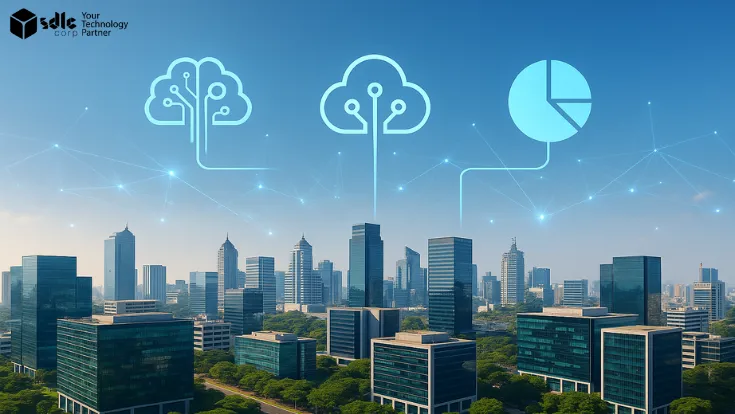Introduction
India has become the global hub for Global Capability Centers (GCCs) — strategic units that drive innovation, analytics, and enterprise transformation for Fortune 500 companies.
As of 2024, India hosts over 1,600 GCCs employing 1.5+ million professionals, contributing USD 45–50 billion annually to the economy (Source: NASSCOM, EY India 2024).
This evolution marks a shift from cost-based outsourcing to value-driven innovation, positioning India as a global digital transformation leader.
1. Understanding Global Capability Centers: The New Nerve Centers of Innovation
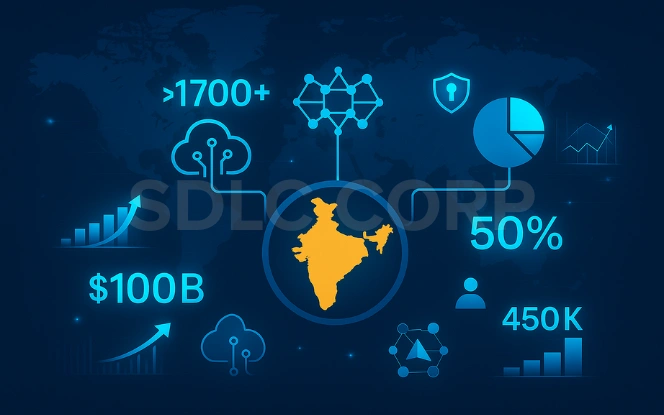
Global Capability Centers (GCCs) are no longer just back-office operations — they’ve evolved into strategic innovation hubs that power an organization’s global digital agenda.
At their core, GCCs are wholly owned subsidiaries or captive units established by multinational enterprises to handle high-value business, technology, and operational processes. These functions span across product engineering, cybersecurity, AI-led analytics, automation, and enterprise IT modernization.
Unlike traditional outsourcing models that prioritize cost savings, GCCs emphasize strategic control, intellectual property ownership, and continuous innovation. They are designed to create enterprise value by combining domain expertise, advanced technologies, and agile methodologies.
GCCs’ Core Purpose
- Innovation Engine: GCCs drive AI, data, and automation initiatives that enhance business agility.
- Operational Excellence: Centralized governance ensures efficiency and standardization across global units.
- Capability Building: They upskill talent in emerging domains like GenAI, RPA, cloud computing, and cybersecurity.
- Customer Experience (CX): Many GCCs now design and manage digital-first experiences across global markets.
Real-World Example
A Fortune 100 retail company’s GCC in Bengaluru developed an AI-driven supply chain visibility platform that improved inventory forecasting accuracy by 35% and reduced last-mile delivery costs by 18% within one fiscal year (Source: Deloitte India GCC Insights 2024).
Learn more: What is GCC?
2. Why India is the Global Leader in GCC Development

India has become the preferred destination for GCC setups due to its unique combination of talent, technology, and scalability.
India’s dominance in GCCs stems from a mix of digital talent, policy incentives, and infrastructure maturity.
| City | Talent Pool (2024) | Core GCC Focus Areas | Avg. Cost Index (vs U.S.) |
|---|---|---|---|
| Bengaluru | 500K+ engineers | AI, cloud, R&D | 0.45x |
| Hyderabad | 350K+ | Fintech, cybersecurity | 0.48x |
| Pune | 200K+ | Data analytics, automation | 0.42x |
| Gurugram | 180K+ | BFSI, consulting | 0.50x |
Drivers:
- Strong STEM talent base (3M+ graduates annually)
- Government incentives: “Beyond Bengaluru,” “Digital India” initiatives
- Mature innovation clusters and global connectivity
Learn more: How much does it cost to set up a GCC in India?
3. GCCs as Engines of Digital Transformation

Modern GCCs drive enterprise-wide digital transformation through cutting-edge tools and measurable results:
- AI & ML adoption: Predictive analytics, fraud detection, and customer intelligence
- Automation (RPA): Workflow optimization; e.g., KYC onboarding time cut by 30%
- Cloud & Cybersecurity: Hybrid cloud adoption, SOC maturity assessments
Data-driven Decisioning: Centralized data lakes improving reporting accuracy by 25%
Case Snapshot:
An American insurer’s Chennai GCC deployed a Zero Trust architecture, reducing security incidents by 42% YoY (2023–24).
Related Insight: AI-First Global Capability Centers (GCCs)
4. The Role of Talent and Skill Transformation
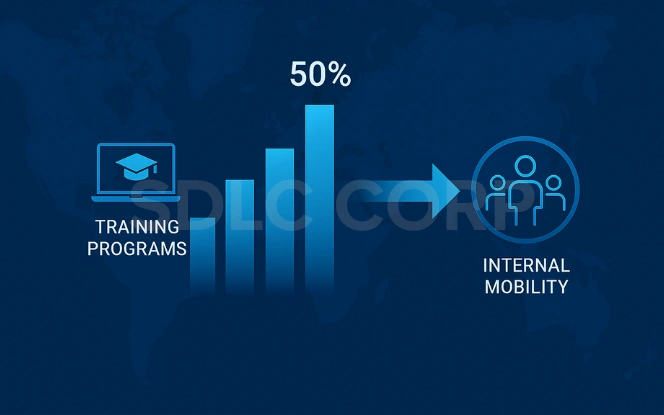
Talent remains the heartbeat of GCC evolution. India’s workforce has matured to meet global demand for next-generation technologies.
Leading GCCs now invest heavily in reskilling initiatives, AI certification, and cloud training. As a result, 50% of India’s GCC workforce is trained in emerging technologies such as AWS, Azure, and GCP.
Moreover, internal mobility programs have improved attrition rates by 15%, creating a more adaptive and future-ready workforce.
Example:
A European telecom GCC implemented an AI-driven career pathing model, reducing voluntary attrition by 12% in one year.
Consequently, India’s talent pipeline is becoming one of the world’s most sustainable engines for innovation.
5. Economic and Strategic Impact of GCCs on India
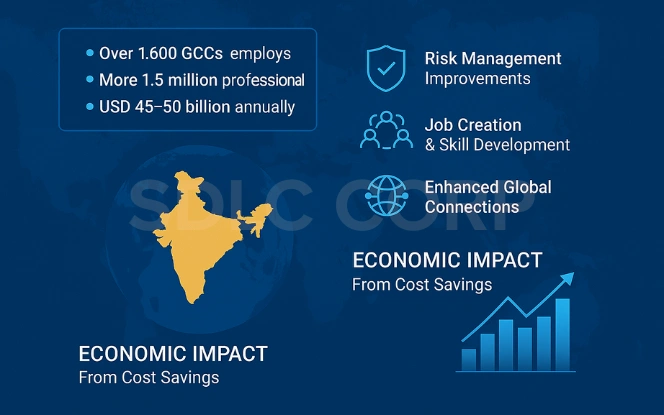
GCCs have become vital contributors to India’s economy and innovation ecosystem.
They follow robust compliance frameworks including ISO 27001, SOC 2, GDPR, and India’s Digital Personal Data Protection Act (DPDP 2023).
Additionally, state-level incentives such as Karnataka’s GCC Policy (2024) and Telangana’s T-Hub grants encourage R&D expansion.
By adopting Zero Trust models, data residency frameworks, and cloud-native security, GCCs are driving resilient digital ecosystems across India.
In the long term, they will form the backbone of India’s trillion-dollar digital economy.
Key frameworks shaping their governance include:
- ISO 27001, SOC 2, and GDPR certifications
- State policies like Karnataka’s GCC incentives (2024) and Telangana’s T-Hub innovation grants
- Data privacy laws under the Digital Personal Data Protection Act (DPDP 2023)
Leading GCCs are adopting data-residency models, Zero Trust frameworks, and cloud-native security to mitigate risks.
The long-term vision is clear: GCCs will be the backbone of India’s digital economy, supporting global enterprises while nurturing indigenous innovation.
6. Models & Costs of GCC Setup
| Model | Ownership | Transition Time | Setup Cost Range (USD) | Capex/Opex Mix |
|---|---|---|---|---|
| Build-Operate-Transfer (BOT) | Parent company (post-handoff) | 18–24 months | $3M – $5M | High Capex → Opex |
| Build-Operate-Transfer-Tweak (BOTT) | Shared with local partner | 12–18 months | $2M – $3.5M | Balanced |
| Build-Operate-Assure (BOA) | Fully managed model | 9–12 months | $1.5M – $2.5M | Opex heavy |
| Hybrid GCC | Co-managed | Flexible | $2M – $4M | Medium |
Insight:
Organizations choosing BOTT models achieve ~25% faster time-to-value and lower transition risk than pure BOT setups (Source: Deloitte GCC Outlook 2024).
Learn more: Build a High-Performance GCC – U.S. Guide
7.Key News and Trends in 2025: India’s GCC Ecosystem Enters Its Next Growth Wave
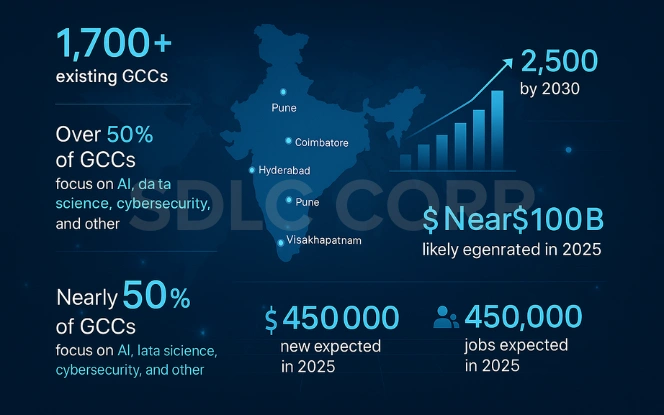
India’s GCC ecosystem is undergoing a historic shift in 2025 — from operational support to global innovation leadership.
More than 50% of GCCs now function as transformation hubs, focusing on AI, data science, and cybersecurity.
Enterprises like Google, Microsoft, SAP, AstraZeneca, and Medtronic are expanding their India-based centers to power global R&D.
As a result, India now hosts 1,700+ GCCs, expected to reach 2,500 by 2030, generating $100B annually and 450,000 new jobs in 2025 alone.
Emerging Tier-2 hubs such as Coimbatore, Jaipur, and Visakhapatnam are gaining attention due to government incentives and digital infrastructure.
Furthermore, the upcoming National GCC Framework (2025) aims to align industry needs with academic programs — creating a future-ready digital workforce.
In summary, India’s GCC growth reflects its ascent as the global capital of enterprise innovation.
Conclusion
The rise of Global Capability Centers in India symbolizes the country’s technological renaissance.
From cost efficiency to innovation leadership, India’s GCCs are shaping the future of global digital transformation.
As companies continue to reimagine operations in the AI era, India stands tall as the innovation partner of choice.
FAQ's
Why Are Global Capability Centers in India Growing Rapidly?
India’s skilled workforce, digital infrastructure, and cost advantage make it the top destination for GCC setups. Companies see India as a center for innovation and scalability.
How Do GCCs Drive Digital Transformation?
GCCs implement AI, automation, cloud computing, and data analytics to modernize business processes and enhance operational efficiency.
Which Industries Benefit Most From GCCs In India?
Sectors like BFSI, IT, healthcare, telecom, and manufacturing lead in GCC adoption, using them to innovate and optimize global operations.
What Is The Future Outlook For GCCs In India?
By 2030, GCCs are projected to contribute over $100 billion to India’s digital economy, with an increased focus on AI-driven innovation and sustainability.
How Are GCCs Different From Outsourcing Companies?
While outsourcing focuses on cost reduction, GCCs offer strategic control, innovation ownership, and integrated value creation for the parent organization.

